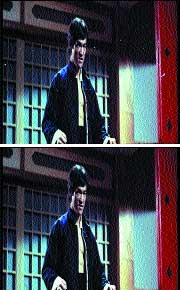 DVDs, HDTV and digital cinema are raising the bar on picture and audio standards and driving the demand for film restoration. As movies are re-released for these new digital markets, film restoration experts say the viewer's growing sophistication and expectations mean that dirt, scratches and other defects are just not acceptable. Even film grain is counter-productive because it wreaks havoc with MPEG compression engines, resulting in wasted bandwidth or storage space.
DVDs, HDTV and digital cinema are raising the bar on picture and audio standards and driving the demand for film restoration. As movies are re-released for these new digital markets, film restoration experts say the viewer's growing sophistication and expectations mean that dirt, scratches and other defects are just not acceptable. Even film grain is counter-productive because it wreaks havoc with MPEG compression engines, resulting in wasted bandwidth or storage space.
While film restoration conjures up images of classic movies affected by decades of wear and tear, many titles being restored are only five or 10 years old, with film elements in comparatively good condition. And some are film-originated TV shows finding a new lease on life on broadcast and cable TV, as well as collector edition DVDs.
Since digital film restoration can be costly, post experts say that the market dictates which projects ultimately get a makeover. However, as the time-consuming, frame-by-frame digital process becomes more automated, this improved cost efficiency is enabling many more aging films, and their historical value, to be preserved for future audiences.
Taking Stock of Film Restoration
"Studios today are taking a pragmatic approach to restorative mastering," says Dick Millais, VP of marketing for IVC High Definition Data Center (www.ivchd.com) in Burbank. "They want to create a best possible universal, electronic master from which all current and future technical deliveries can be made. This type of master is ideal for servicing all requirements, including SDTV, HDTV, DVD, digital cinema, data and HD-DVD. It saves money without any technical compromise. Using proprietary restoration solutions, IVC restored and remastered the movie Akira, (Pioneer Entertainment) for digital cinema and DVD.
"The words 'digitally remastered' often have different meanings. It could be a quick digital transfer on a limited budget, just good enough for viewing cassettes, or an extensive restoration to assure the quality necessary for high-end deliveries, future sales and archival preservation," adds Millais.
 The first step is a technical evaluation of all existing film preprint elements (optical and magnetic) to determine their condition and make sure there's a complete useable picture and track to work with. Scenes may be missing from the best element (which have to be found in other elements); a new wet gate interpositive (IP) may have to be made for best transfer; or severely damaged scenes may require digital rebuilding. If the movie pre-dates 1950, its negative and preprint elements will likely to be on nitrate base film, which means extra care must be taken in the inspection and handling of those elements. Digital picture restoration encompasses removing evidence of film defects, such as scratches, rips, tears, dirt, hair or sprocket damage. It can also include correction for differential fading - if part of the picture or reel faded unevenly; for color "breathing" or pulsing; or for where different film batches and emulsions in one movie have aged differently. Even if a film is only 10 to 20 years old, there can be serious color fading if it was stored improperly.
The first step is a technical evaluation of all existing film preprint elements (optical and magnetic) to determine their condition and make sure there's a complete useable picture and track to work with. Scenes may be missing from the best element (which have to be found in other elements); a new wet gate interpositive (IP) may have to be made for best transfer; or severely damaged scenes may require digital rebuilding. If the movie pre-dates 1950, its negative and preprint elements will likely to be on nitrate base film, which means extra care must be taken in the inspection and handling of those elements. Digital picture restoration encompasses removing evidence of film defects, such as scratches, rips, tears, dirt, hair or sprocket damage. It can also include correction for differential fading - if part of the picture or reel faded unevenly; for color "breathing" or pulsing; or for where different film batches and emulsions in one movie have aged differently. Even if a film is only 10 to 20 years old, there can be serious color fading if it was stored improperly.
Films blessed by Archangel
"We take restoration very seriously," says Godfrey Pye, president of Hollywood's Sunset Digital (www.sunsetpost.com), which digitally masters "A" movies. "We have two dedicated audio restoration specialists plus three digital picture restoration artists. With their combined experience, we're confident we can correct almost any film defect.
"Our digital restoration business has been soaring. Why? Well, if you are the owner of a catalog of legacy movies or shows which require some smartening up before they can become saleable, we recognize that there is an appropriate rate to charge for this work as it's most likely not destined for primetime viewing," continues Pye. "My advice is do it now before your material deteriorates further - and do it digitally."
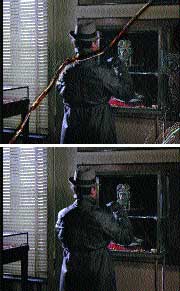 For Snell & Wilcox's Archangel Ph.C image restoration system, the rate is $10 per minute of material, plus hire of VTRs and stock. (Archangel is a realtime, automated digital system that uses motion estimation to remove dirt, scratches, stabilize shots, reduce grain and other fixes transparently.) For Digital Vision's DRS system, which is frame-by-frame, (and for the 24/96 Sadie Artemis audio workstation integrated with the Cedar audio restoration suite), Sunset quotes a price upfront on a per-job basis.
For Snell & Wilcox's Archangel Ph.C image restoration system, the rate is $10 per minute of material, plus hire of VTRs and stock. (Archangel is a realtime, automated digital system that uses motion estimation to remove dirt, scratches, stabilize shots, reduce grain and other fixes transparently.) For Digital Vision's DRS system, which is frame-by-frame, (and for the 24/96 Sadie Artemis audio workstation integrated with the Cedar audio restoration suite), Sunset quotes a price upfront on a per-job basis.
"All digital restoration systems work by comparing the frames surrounding a damaged frame, then 'deciding' to use the healthy information to replace what's missing in the damaged frame," says Pye. "If the damage is huge, and the shot has insufficient comparison information, then the only solution is a talented, artistic restoration staff that has been there, done it and can wield a digital paintbrush with ?lan."
Projects recently restored at Sunset include The Man From Rio, Enemy of the State, Blue Velvet, Bull Durham, Inherit the Wind, Mad Max, Spaceballs, Thelma and Louise, and The Great Escape.
Dust Busters
"My advice is to work off the original negative whenever possible, and allow plenty of time. A feature film could need 250 hours of retouching and dust busting," says Chris Timson, senior editor for Elite Television, a post production/effects company in Leeds, England. Elite restored Bruce Lee's The Big Boss, Fists of Fury and Game of Death for DVD release.
Elite uses Discreet Smoke for restoration, especially the image stabilizer to remove weave, and the paint tool for quickly moving from one frame to another. They also use Colorfront's star*dust image restoration suite, marketed by effects developer 5D in the UK, especially for scratch, dust and noise removal, done automatically overnight. "Every job is unique," says Timson, "and what fixes a scratch on one film doesn't necessarily work for another."
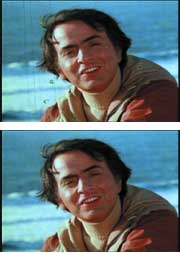 Like Elite TV, Hollywood-based Still In Motion (stillinmotion.com) also relies on workhorse systems, like Quantel Paintboxes and Editboxes for restoration (but sees business shifting to facilities with faster, cheaper digital restoration systems). An Editbox was used to restore 13 one-hour episodes of Dr. Carl Sagan's Cosmos, from the original 1979-1980 1-inch videotape masters. "The frame-by-frame restoration combined with additional signal processing [when we encoded the masters], has turned out a Collectors Edition DVD set that looks better than the original TV series," says Steve Wiskocil, president of Still In Motion, a DVD service in Hollywood.
Like Elite TV, Hollywood-based Still In Motion (stillinmotion.com) also relies on workhorse systems, like Quantel Paintboxes and Editboxes for restoration (but sees business shifting to facilities with faster, cheaper digital restoration systems). An Editbox was used to restore 13 one-hour episodes of Dr. Carl Sagan's Cosmos, from the original 1979-1980 1-inch videotape masters. "The frame-by-frame restoration combined with additional signal processing [when we encoded the masters], has turned out a Collectors Edition DVD set that looks better than the original TV series," says Steve Wiskocil, president of Still In Motion, a DVD service in Hollywood.
"If clients are too budget challenged to do a full restoration, encourage them to devise a list of 'worst case fixes,' then concentrate on repairing only those," says Wiskocil. "Also, automatic defect removal needs to be managed because some particles, like dust from explosions, or highlights in character's eyes, are not flaws but content, and only people can make that determination."
Going for Pristine
"The best advice I can give is that, when clients wish to restore movies, they should speak with us prior to the film transfer to HD videotape," says John D. Lowry, owner of Burbank's Lowry Digital Images. "All too often, there are techniques used in the telecine transfer that actually degrade the picture. They think they are improving the picture - like to make it sharper - but if it is not done properly, it can hamper digital restoration. With our digital restoration tools, we can sharpen the picture to an incredible extent, with no harsh edges."
Considered an expert in digital film restoration, Lowry has restored hundreds of movies for Warner Bros., Disney, MGM, Paramount and others, including the classics Dr. Zhivago, Citizen Kane, North by Northwest, Little Women and Gone With the Wind.
In preparation for digital restoration, film elements must be digitized. And the decision as to whether to scan at 3K or 4K on a conventional scanner versus a faster 2K scan on a HD telecine depends upon time and money. "If the budget allows, it's great to scan original color negative at 4K on a conventional scanner. But some elements, like interpositives, may not have 4K worth of information to scan," says Lowry. "Also, if you scan an image at 2K on an HD telecine, oftentimes, you're losing half the chrominance data and degrading the image. You might be able to bring that lost color data back by processing it but, generally speaking, full-bandwidth RGB scanned from a conventional scanner is superb. 2K on a telecine is a step down from that, and HD is a step down from that."
 While wet gate film processing mitigates dirt and scratches on the surface of film, Lowry says that only digital restoration tools can clean up dirt and scratches printed into the film element, or tackle serious problems like grain, jitter, weave and flicker. With his network of over 200 computers, and top-flight proprietary digital film restoration software, 99.95 percent of those defects are removed automatically. "I've restored over two dozen movies in the last 18 months, including films suffering from rips, tears, missing scenes and other devastating damage," he says. "In every case, I've been able to repair them to the point where the scenes look pristine."
While wet gate film processing mitigates dirt and scratches on the surface of film, Lowry says that only digital restoration tools can clean up dirt and scratches printed into the film element, or tackle serious problems like grain, jitter, weave and flicker. With his network of over 200 computers, and top-flight proprietary digital film restoration software, 99.95 percent of those defects are removed automatically. "I've restored over two dozen movies in the last 18 months, including films suffering from rips, tears, missing scenes and other devastating damage," he says. "In every case, I've been able to repair them to the point where the scenes look pristine."
Cutting Edge of Restoration
At LA's The Post Group (www.postgroup.com), digital restoration is done using da Vinci's RS2 or MTI's DRS. Rory Lubold, The Post Group's VP engineering, says, "They each have their own strengths and weaknesses, but between the two we have everything we need for image restoration. Both da Vinci and MTI have been pushing to automate the process, as well as to offer faster, distributed rendering on less expensive rendering boxes, which can translate into client savings."
Mathematical Technologies, Inc. (www.mathtech.com), or MTI, based in Providence, R.I., offers DRS, Digital Restoration Services software, which removes dust, chemical stains, reduces grain, removes flicker, stabilizes images, does aperture and cadence correction and more.
RS2, formerly known as the Revival Digital film restoration system (developed in Singapore), is now part of the da Vinci ReStor Product Group (www.davsys.com). Resolution-independent RS2 automatically analyzes and processes images without operator assistance (for dust, stain, grain and noise removal; severe frame damage repair like splices; and specialized subtitle processing.). RS2's interactive mode allows fine-detail restoration on a frame-by-frame basis.
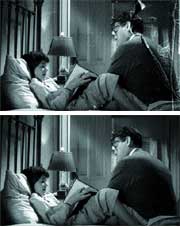 As a beta test site for both da Vinci and Discreet, The Post Group is helping to develop a version of RS2 that's integrated with Discreet's Back Draft. "The underlying philosophy is very good. RS2 can restore any image as it's going in or out of the Discreet frame store when you're working with Discreet's editing or compositing systems," says Lubold
As a beta test site for both da Vinci and Discreet, The Post Group is helping to develop a version of RS2 that's integrated with Discreet's Back Draft. "The underlying philosophy is very good. RS2 can restore any image as it's going in or out of the Discreet frame store when you're working with Discreet's editing or compositing systems," says Lubold
The Post Group recently completed The Bond Picture Show, a series of classic James Bond movies, which were restored and 24p HD mastered for ABC, which will air one per month in HDTV in 2002. The Post Group also restored Se7en: Special Edition, for New Line Cinema for Platinum Series DVD. Released in 1995, the movie Se7en required noise, grain and light scratch clean up, all of which was done in an automated pass by RS2. The Post Group also restored the 1954 classic There's No Business Like Show Business for the Twentieth Century Fox Marilyn Monroe Diamond Collection DVD. Another image restoration tool is Digital Vision's ASC, which performs realtime dirt and scratch removal (see www.digitalvision-usa.com). LA-based Post Logic (www.postlogic.com) uses ASC along with Digital Vision's AGR grain reducer for digital cinema or DVD projects. "The ability to do dirt concealment in realtime means that we minimize for our clients the amount of work that needs to be done in a non-realtime restoration environment," says Lou Levinson, senior colorist at Post Logic. "With clean elements in good condition, or with a moderate level of dirt, we can generate very clean masters in realtime. The more problematic the element, like scratches across moving faces and torn sprockets, the more the advantage shifts to non-realtime systems [like Discreet Flame].
"There are no free or bargain lunches," adds Levinson. "Getting it done right the first time is always the best and usually least expensive path. For restoration, this means good people using the right tools and an awareness that, especially on older, poorly-stored films, there are limits to what one can do."
Going Back to Cheers
As a vendor to Paramount's Television Group, IVC contributed to the restoration of Cheers, the top-rated, long-running 1980s TV sitcom series, remastered to HD.
While most film restoration work focuses on motion pictures, occasionally studios need to restore classic TV shows shot on 35mm film. In the case of Cheers, the original negative was in good condition. But, because of the technical limitations of telecine technology in the early 1980s, the pictures seemed softer and lacking detail compared to today's filmed shows.
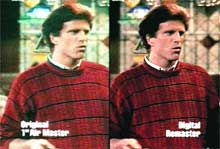 "Since today's telecines can extract more information from film than was possible in the 1980s, by restoring the shows and re-transferring them to HD, we could present them with quality comparable to what viewers have become accustomed to seeing on television today," says Phil Murphy, senior VP operations for Paramount Television Group, Paramount Pictures, in Hollywood.
"Since today's telecines can extract more information from film than was possible in the 1980s, by restoring the shows and re-transferring them to HD, we could present them with quality comparable to what viewers have become accustomed to seeing on television today," says Phil Murphy, senior VP operations for Paramount Television Group, Paramount Pictures, in Hollywood.
Cheers was restored specifically for Nickelodeon, which began airing the series in the fall of 2001 in its Nick-at-Night primetime block. According to Murphy, the color negatives for 275 episodes (2,600 cartons of film canisters) were pulled from an environmentally controlled vault.
"This was a very labor-intensive process that involved identifying all the reels, scenes and shots from film and matching them up with the original programs mastered on 1-inch videotape, "says Murphy. Back then, it was not standard practice for tape editors to track film frames, or to necessarily conform the negative. So the process involved cutting the color negatives, making wet gate interpositives and re-transferring that film to HD. Besides running on Nickelodeon, this restored version is also being syndicated to TV stations.
"With digital clean-up to remove minor dust and scratches, we produced a pristine version of Cheers, and the interpositives and the D-5 master now reside in an environmentally controlled vault," says Murphy. "While we now have a D-5 master, it was very important to have an optical master because film offers the highest resolution of any storage medium."
A Refreshing Alternative
In 1995, while producing a documentary about the atom bomb, called Trinity and Beyond, Peter Kuran developed RCI (Restored Color Image), a photochemical process for restoring color to faded motion picture color negatives, without adding grain.
"RCI rivals digital restoration systems in image quality," says Kuran, president of VCE (www.vce.com/rci.html) and a visual effects specialist in Hollywood. "And since digital restoration costs about four times more than RCI, this affordable approach is enabling more film records to be preserved for posterity." Cinetech, a premier film laboratory in Hollywood, licensed RCI from VCE to expand its film restoration services. This patent-pending process produces a new intermediate film element with restored color, fine grain and retention of shadow detail, which is ideal for archive.
When faded color negative is optimally captured digitally, Kuran says that the red and green channels contain only 65 to 75 percent of possible data while the blue channel contains less than 25 percent of possible data: "In other words, you don't have much data to work with. When this digital data is stretched to fill the proper color space, you see digital artifacting, spectral sampling errors and anomalies like posterization. And wet gate methods don't increase the grain the way that dry gate [digital scanning] can."
Among the films restored using RCI are The Seven Year Itch (1955), Decision at Sundown (1957), Picnic (1955) and 100 Years of Disney (color negative from the 1950s) for Disney's new Disneyland exhibit.
"When used together, wet gate printing and the RCI color restoration process can solve most of the problems [dust, scratches and faded color] plaguing older 35mm features," Kuran says, "Then, problems like torn film or sprockets - which occur about 10 percent of the time and cannot be addressed with RCI - can be brought into the digital environment for fixing, making it a cost-effective approach, especially when there are large quantities of footage to be restored."